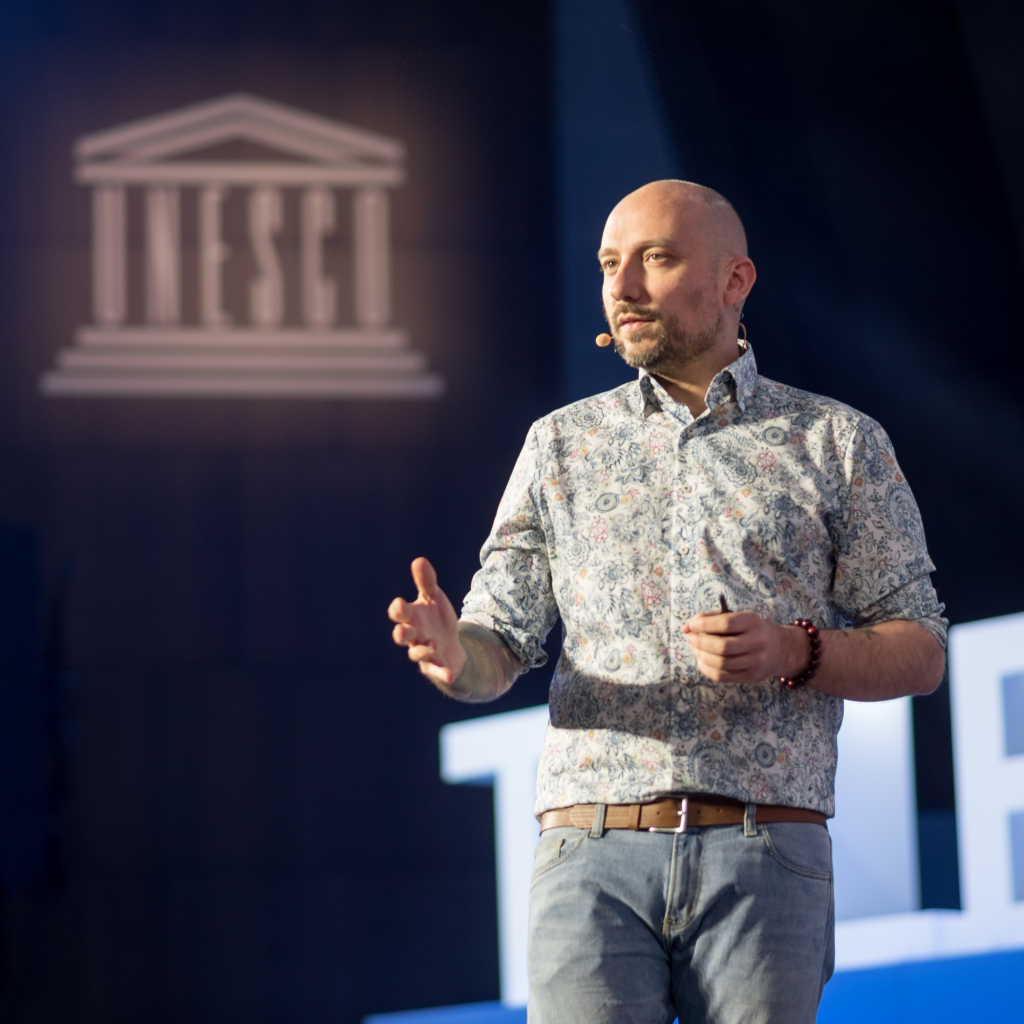As the Covid-19 pandemic upsets businesses and communities around the world, many of us have looked to our managers to lead. To lead us not only through these turbulent professional times, transitioning to working from home and questions of job security, but also through the emotional stress that has come with lockdowns and social distancing.
During this period, managers have worn many hats: those of mentors, cheerleaders, entrepreneurs, business leaders and more. So what then does it actually take to successfully manage and lead today?
To answer this question, we asked a professor, a business leader and a student to share their thoughts. And what they said came down to one thing: be true to yourself.
The Evolution of Management, or How We Got Here
According to Alexandre Tissot, ESCP affiliate professor and founder of AT Transformations, we’ve experienced many “fashions” of management throughout the history of business, with these management styles shared across sectors.
However, as companies began to understand the power of people and the need to differentiate, the place of management in business strategy has shifted.

I think what has changed the most in the past 10 years is that every company has learned to see management more widely, as one of the key ways to deliver performance inside the company.
The three-fold crisis, health, economic and social, has in many aspects continued to broaden our understanding of management. “We used to train managers and to have managers in companies that were planning everything,” says Tissot. Until uncertainty threw a wrench in the machine.
It [uncertainty] has always been there. But I think for the first time we are pointing at it and living it directly.
Management is no longer about predicting problems but facing them and finding real solutions. Managers are expected to lead, to be creative, to be innovative, and to encourage these same qualities in their teams. “And that’s why, I would say that we have to be really deeply connected to our humanity to face this uncertainty.”
The concept of “human-centered” leadership is nothing new.
For example, in 1970, Robert K. Greenleaf coined the term “Servant Leadership,” which expressed the idea that leaders should “focus primarily on the growth and well-being of people and the communities to which they belong.” CSR (corporate social responsibility) has also gained traction, placing employee well-being among a business’ key responsibilities.
What the global health crisis has shown us, however, is that placing people first, whether we call them stakeholders, employees or communities, is a necessity.
Before the pandemic, awareness of people-first management was spreading. Management has become part of a brand’s DNA, with “employee engagement” as a buzzword of the decade. Think Silicon Valley startups touting a bottom-up management style or Tesla’s flat management structure. How businesses manage their employees has become a key element to attracting and retaining talent, encouraging brand loyalty among consumers, and much more.
“We have seen that in the past 20 years the question was about money. Now, the first question is management,” says Tissot.
People don’t leave companies, as much as before, because they don’t have a good income, etc. They’re leaving because they don’t have the right management.
According to a 2017 Gallup Survey, highly engaged business units measured “a 41% reduction in absenteeism and a 17% increase in productivity” with those in high-turnover organizations achieving “24% less turnover.”
Is it really a question of generation or are we all looking for more human leadership?
According to Claire Madden, author and social researcher, Gen-Z employees are looking for leaders that are “real, authentic, relational and genuine,” capable of creating a safe environment for contribution and learning. “Old models and approaches that gained traction in past eras are no longer gaining currency or attaining cut through in this redefined social context with emerging generations.”
Alexandre Tissot disagrees. “I think people that are older today are expecting exactly the same thing as young generations. They want to be singular, they want to be seen for who they are and no more about their diplomas or past jobs or titles.”
Whether he is coaching business clients or teaching students, Tissot advises everyone to be themselves and works with them to discover exactly what that means.
I think, with examples like Steve Jobs, Elon Musk, Bezos, etc, what is tremendous about them is that they are very clear about who they are. They don’t hide anything. In fact, when they talk, you see what they believe in, what their convictions are, and how they see the future. And I think that’s key.
As 2nd-year ESCP Master in Management student, Lara Gualtieri sees it, this passion coupled with resilience is what makes a leader.

To become a leader, you have to be resilient, and I think that’s something that should be an inherent quality of who you are. There will be so many challenges pulling you in different directions when, in fact, you need to stay focused to not lose enthusiasm. Leading requires being able to assess priorities, adjust and be able to push back when needed.
While certain hard skills are necessary, “what really makes the difference is how you are able to communicate, work and cooperate with others,” says Gualtieri. This means capabilities like “the ability to listen,” “have empathy” and “not only accept but also value diversity” are what make a good leader.
“I think being a leader is also having the ability to understand that you may be on the top, yet there may be other professionals that bring value to a team. A leader’s most crucial task is to value and recognize those talents as well.”
“Intrinsic capabilities are more important to leadership than skills.”
For Catherine Barba, digital pioneer, tech entrepreneur, and investor, creating a sense of belonging and building emotional connections are key ingredients in her leadership method.
People probably feel like following me in my many crazy ventures because it’s so much fun working together, because they learn a lot, and because they clearly understand the direction and the meaning of what we’re building together.
But Barba also argues that intrinsic capabilities are more important to leadership than skills. “Mine are a tremendous amount of energy, empathy and my capacity to constantly question the status quo.”
As an investor, Catherine Barba looks for small, diverse teams made up of people who are very knowledgeable about their space, hardworking, humble and continuous learners. “I love people that I would want my closest friends to work for.” And in defining her own leadership, Barba qualifies herself as a “new power” leader.
I don’t believe that power is something to be seized and then jealously guarded. Power is made by many, it is open, participatory and peer-driven. I believe a company is a sum of networks, whose success relies on the autonomy, agility, commitment and excellence of everyone.

As her teams adapted to remote working over the last few months, these qualities are exactly what helped her maintain a sense of belonging. For example, what worked for her was:
- “Establishing rituals, one-on-one as well as collective frequent short meetings in order to track “weak signals” of discouragement, lack of commitment, anxiety, and to make people feel they share a collective vision and invent the future together.
- Energizing people, and connecting emotionally.”
“It is who you are that will make the difference in management.”
The right management style used to come from the top down. Today, a successful manager is one who builds it from the bottom up, grounding their style in their values, their passions, in what makes them unique.
While it is clear that some common abilities, such as: multidisciplinary skills, persistence, system thinking, may set leaders up for success in the face of major transformation, management has become less a question of tools or methodologies.
“Of course, you need some of them. I’m not saying we have to forget everything,” Tissot says. “I do think you need to have that, but never forget that it is who you are that will make the difference in management.” Especially in times of uncertainty.
Feature photo credit: Monkey Business – stock.adobe.com.
License and Republishing
The Choice - Republishing rules
We publish under a Creative Commons license with the following characteristics Attribution/Sharealike.
- You may not make any changes to the articles published on our site, except for dates, locations (according to the news, if necessary), and your editorial policy. The content must be reproduced and represented by the licensee as published by The Choice, without any cuts, additions, insertions, reductions, alterations or any other modifications.If changes are planned in the text, they must be made in agreement with the author before publication.
- Please make sure to cite the authors of the articles, ideally at the beginning of your republication.
- It is mandatory to cite The Choice and include a link to its homepage or the URL of thearticle. Insertion of The Choice’s logo is highly recommended.
- The sale of our articles in a separate way, in their entirety or in extracts, is not allowed , but you can publish them on pages including advertisements.
- Please request permission before republishing any of the images or pictures contained in our articles. Some of them are not available for republishing without authorization and payment. Please check the terms available in the image caption. However, it is possible to remove images or pictures used by The Choice or replace them with your own.
- Systematic and/or complete republication of the articles and content available on The Choice is prohibited.
- Republishing The Choice articles on a site whose access is entirely available by payment or by subscription is prohibited.
- For websites where access to digital content is restricted by a paywall, republication of The Choice articles, in their entirety, must be on the open access portion of those sites.
- The Choice reserves the right to enter into separate written agreements for the republication of its articles, under the non-exclusive Creative Commons licenses and with the permission of the authors. Please contact The Choice if you are interested at contact@the-choice.org.
Individual cases
Extracts: It is recommended that after republishing the first few lines or a paragraph of an article, you indicate "The entire article is available on ESCP’s media, The Choice" with a link to the article.
Citations: Citations of articles written by authors from The Choice should include a link to the URL of the authors’ article.
Translations: Translations may be considered modifications under The Choice's Creative Commons license, therefore these are not permitted without the approval of the article's author.
Modifications: Modifications are not permitted under the Creative Commons license of The Choice. However, authors may be contacted for authorization, prior to any publication, where a modification is planned. Without express consent, The Choice is not bound by any changes made to its content when republished.
Authorized connections / copyright assignment forms: Their use is not necessary as long as the republishing rules of this article are respected.
Print: The Choice articles can be republished according to the rules mentioned above, without the need to include the view counter and links in a printed version.
If you choose this option, please send an image of the republished article to The Choice team so that the author can review it.
Podcasts and videos: Videos and podcasts whose copyrights belong to The Choice are also under a Creative Commons license. Therefore, the same republishing rules apply to them.





